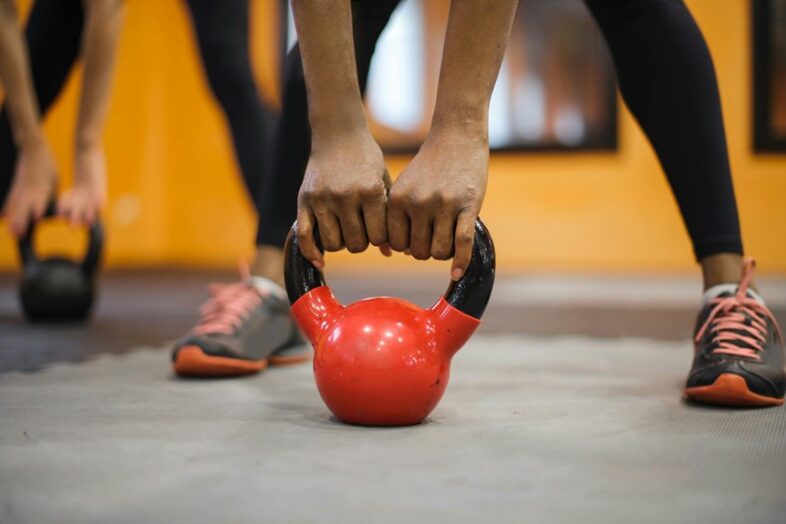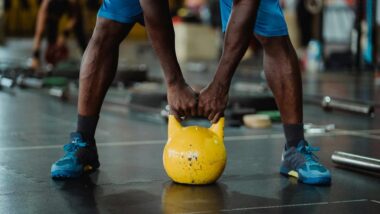Kettlebell Leg Workout for Beginners
Kettlebell leg workouts pack a serious punch when it comes to building lower body strength, power, and endurance.
Unlike traditional gym equipment that isolates single muscles, exercises like goblet squats and kettlebell swings work multiple muscle groups at once—giving you more bang for your buck.
You’ll see improvements not just in leg strength and stability, but in your cardiovascular fitness and overall athletic performance too.
The catch? Technique matters. A lot. Get the form right, and you’re on track for impressive gains. Get it wrong, and you’re asking for trouble.
That’s why understanding the basics is so crucial, especially if you’re new to kettlebell training. Once you nail the fundamentals, you’ll have everything you need to build seriously strong, resilient legs.
Key Points to Remember:
- Start with goblet squats to target your quads and glutes
- Master the kettlebell swing for better hip mobility and strength
- Never compromise on proper form—it’s your best injury prevention
- Add deadlifts for comprehensive leg development
- Consistency beats intensity when you’re starting out
Essential Kettlebell Leg Exercises
When you’re building a strong lower body foundation, kettlebell exercises offer incredible versatility. Each movement targets different muscle groups, so you can create a well-rounded routine that hits everything from your calves to your glutes.
The kettlebell goblet squat is perfect for beginners. It’s straightforward, targets your quadriceps and glutes effectively, and teaches you the proper squatting pattern you’ll use in more advanced exercises.
Kettlebell swings take things up a notch by engaging your hips and lower back—two areas that are absolutely critical for maintaining good form and preventing injuries down the road.
Don’t overlook deadlifts and traditional squats either. These compound movements work multiple muscle groups simultaneously, making them incredibly efficient for building overall strength.
When you combine these exercises into a regular routine, you’re not just building stronger legs. You’re improving stability, enhancing athletic performance, and increasing mobility in your hips, knees, and ankles. What makes kettlebell training especially appealing is its adaptability.
Whether you’re a complete beginner or someone with years of training experience, you can modify the weight, reps, and complexity to match your current fitness level and goals.
Building Real Strength
A smart kettlebell leg workout does more than just make your legs stronger—it creates a foundation for everything else you do, whether that’s playing sports, hiking with friends, or just feeling more confident in your daily activities.
The beauty of exercises like goblet squats, single-leg deadlifts, and front squats is their practicality. These aren’t just gym movements; they mirror the way your body naturally moves in real life.
Single-leg deadlifts, for instance, don’t just build strength—they improve your balance and teach each leg to work independently. Front squats challenge your core stability while working your entire lower body.
Kettlebell swings deserve special mention here. They’re dynamite for developing explosive power and endurance, two qualities that translate directly to better athletic performance and everyday activities.
The cardiovascular benefits are substantial too. Because these exercises engage large muscle groups and often your whole body, your heart rate stays elevated throughout the workout.
You’re essentially getting strength training and cardio rolled into one efficient session.
Creating Your Routine
A well-designed kettlebell routine doesn’t need to be complicated to be effective. For beginners, focusing on three core movements—swings, goblet squats, and deadlifts—provides a solid foundation that you can build on over time.
Start with 3 sets of 8-12 repetitions for each exercise, resting 60-90 seconds between sets. This gives your muscles time to recover while keeping the workout moving.
As you get stronger and more comfortable with the movements, you can increase the weight, add more sets, or incorporate more challenging variations.
The kettlebell swing is particularly valuable because it teaches the hip hinge movement pattern that’s fundamental to so many other exercises.
Master this, and you’ll have a much easier time progressing to more advanced movements like the kettlebell deadlift and various lunge variations.
If you’re looking to maximize calorie burn and boost your fitness even further, consider adding some high-intensity interval training (HIIT) principles to your kettlebell sessions.
The combination can be incredibly effective for both strength gains and fat loss.
Why This Approach Works
The benefits of kettlebell leg training extend far beyond just having stronger legs. When you consistently work these large muscle groups with compound movements, you’re improving your body’s ability to generate power and move efficiently.
Exercises like sumo swings specifically target your inner thighs, glutes, and hamstrings—areas that often get neglected in traditional training programs.
Stronger glutes and hamstrings don’t just look good; they’re crucial for preventing lower back pain and improving your performance in virtually every sport and physical activity.
The mobility improvements are equally important. Regular kettlebell training helps maintain and improve range of motion in your hips, knees, and ankles—joints that tend to get stiff from too much sitting and not enough varied movement.
Getting Your Technique Right
Here’s the thing about kettlebell training: technique trumps everything else. You can have the heaviest kettlebell in the gym, but if your form is off, you’re not getting the full benefit—and you’re risking injury.
The hip hinge movement is absolutely fundamental. Whether you’re doing swings, deadlifts, or lunges, learning to move from your hips rather than your knees or back is crucial.
This movement pattern is what allows you to generate real power and keeps your spine safe during heavy lifts.
For exercises that use the front rack position (like goblet squats), focus on keeping your core engaged and your chest up. The weight should feel secure against your body, not like it’s pulling you forward or throwing you off balance.
Take time to learn each movement properly before adding weight or speed. Your future self will thank you for building good habits from the start.
Common Questions:
Can you build legs with just kettlebells? Absolutely. Kettlebell exercises like swings, squats, and deadlifts are incredibly effective for building leg strength and muscle. The key is progressive overload—gradually increasing the challenge as you get stronger.
What weight should beginners start with? Most beginners do well starting with an 8-12 kg (roughly 18-26 pound) kettlebell. Focus on perfecting your form before worrying about the weight on the bell.
Is 20 minutes enough for a kettlebell workout? Twenty minutes of focused kettlebell training can be incredibly effective. Because these exercises work multiple muscle groups and elevate your heart rate, you can accomplish a lot in a short timeframe.
How long should beginner leg workouts be? For beginners, 15-30 minutes is plenty. This gives you enough time for a proper warm-up, your main exercises, and a cool-down without overwhelming your recovery capacity.
The journey from weak to strong isn’t always linear, but it’s always worthwhile. Each workout builds on the last, gradually transforming not just your legs but your entire relationship with physical challenges.
What starts as a simple desire to get stronger becomes something much more significant—a foundation of confidence that carries into every aspect of your life.


